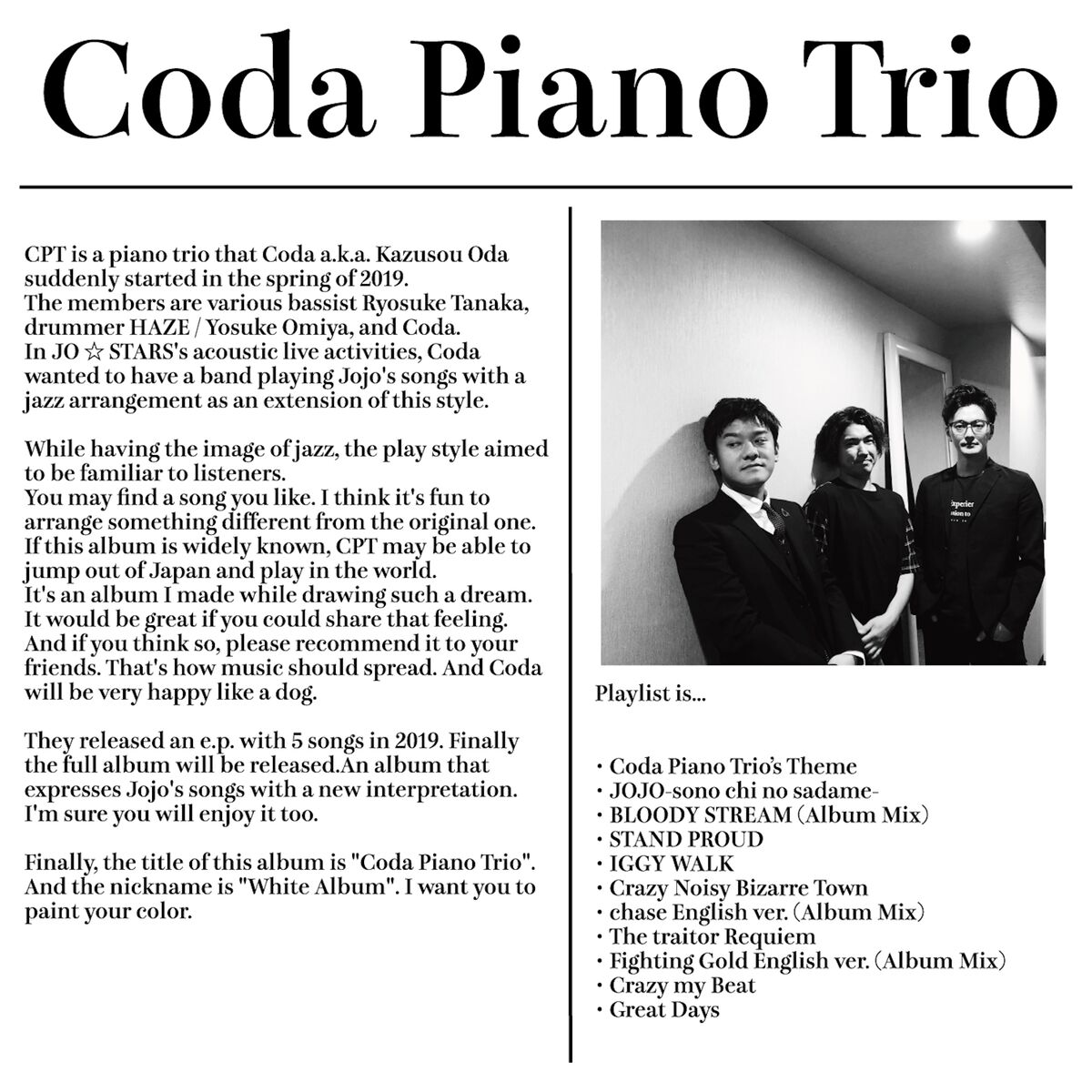Mastering Coda Piano: The Ultimate Guide For Aspiring Musicians
Have you ever wondered what makes a piano piece truly unforgettable? It's not just about hitting the right notes or playing with perfect timing. It's about understanding the magic of coda piano. Coda piano is like the cherry on top of an already delicious musical sundae. It's that extra flair that leaves listeners wanting more. Whether you're a seasoned pianist or just starting out, mastering coda piano can take your performances to the next level.
Think about it. You're playing a beautiful piano piece, and just when you think it's wrapping up, BAM! A coda comes in and elevates the entire experience. It's like a hidden treasure waiting to be discovered. But what exactly is coda piano? And how can you incorporate it into your playing? Stick around because we're about to dive deep into everything you need to know about coda piano.
Before we get into the nitty-gritty, let me tell you something. Coda piano isn't just for classical music enthusiasts. It's for anyone who loves music and wants to add a touch of brilliance to their performances. So, whether you're jamming at home or performing on stage, this guide will help you unlock the secrets of coda piano. Let's get started, shall we?
- Dadne Keen The Rising Star Whos Captivating Audiences Worldwide
- Did Fox News Fire Jessica Tarlov Unpacking The Drama Behind The Headlines
What Exactly is Coda Piano?
Alright, let's break it down. Coda piano, or simply coda, is a musical term used to describe a passage that brings a piece to a conclusion. Think of it as the grand finale of a fireworks show. It's that moment where everything comes together, leaving a lasting impression on your audience. Codas can be simple or elaborate, depending on the composer's intention and the style of the piece.
Here's the cool part. Codas aren't limited to just one type of music. They appear in classical compositions, jazz pieces, pop songs, and even film scores. The beauty of coda piano lies in its versatility. You can use it to wrap up a complex symphony or add a little flair to a simple melody. It all depends on how creative you want to get.
Why is Coda Piano Important?
Now, you might be wondering, why should I care about coda piano? Well, here's the thing. Codas serve a crucial purpose in music. They provide closure and bring a sense of completion to a piece. Without a coda, a song might feel unfinished or leave the listener hanging. It's like ending a story without a proper conclusion. Just doesn't sit right, does it?
- Tom Hardy As Batman Why The Dark Knight Could Be In Good Hands
- Where Does Laufey Live Unveiling The Mythical Home Of A Legend
But that's not all. Codas also allow musicians to showcase their skills and creativity. They give you the opportunity to leave a lasting impression on your audience. Imagine playing a breathtaking coda that leaves everyone in awe. That's the power of coda piano. It takes your performance from good to unforgettable.
How to Identify a Coda in Music
So, how do you spot a coda in a piece of music? It's actually easier than you think. Composers often use specific markings to indicate the start of a coda. Look out for the symbol "CODA" or the Italian word "Coda" written in the score. Sometimes, you'll see a double barline followed by a coda sign, which looks like an oval with a dot in the middle. These signs are your cues to transition into the coda section.
Here's a quick tip. Pay attention to the structure of the piece. Codas usually appear towards the end, after the main themes have been presented. They might introduce new material or revisit familiar motifs in a fresh way. By understanding the structure, you'll be able to anticipate when a coda is coming and prepare yourself for it.
Common Coda Symbols in Sheet Music
- CODA: A straightforward indication that a coda is approaching
- Coda Sign: An oval with a dot, often used in conjunction with a double barline
- D.C. al Coda: Indicates that you should return to the beginning and play until the coda sign
- D.S. al Coda: Tells you to jump to a specific section marked with "Segno" and play until the coda sign
Understanding the Role of Codas in Different Genres
Now that we know what codas are and how to identify them, let's explore how they function in various genres. In classical music, codas are often elaborate and serve as a grand conclusion to a movement or piece. Composers like Mozart and Beethoven were masters of crafting memorable codas that left audiences in awe.
In jazz, codas are more spontaneous and improvisational. Musicians use them to bring a performance to a satisfying close while showcasing their individual style. Pop songs also utilize codas, though they tend to be simpler and more repetitive. Think of the extended outro of a hit song that gets stuck in your head. That's a coda in action.
Examples of Iconic Codas in Music
- Mozart's Symphony No. 40: A brilliant coda that wraps up the final movement with flair
- Beethoven's Symphony No. 9: The iconic "Ode to Joy" coda that leaves listeners in awe
- Queen's "Bohemian Rhapsody": A coda that combines rock and opera elements for a grand finale
Practicing Coda Piano: Tips and Techniques
Alright, let's talk about the fun part. How do you practice coda piano and make it sound amazing? First things first, start by analyzing the score. Break down the coda into smaller sections and focus on mastering each part individually. Pay attention to dynamics, articulation, and phrasing. These elements will help you bring the coda to life.
Here's a pro tip. Record yourself playing the coda and listen back to identify areas for improvement. Pay attention to your timing, accuracy, and expression. Are you conveying the intended emotion? Are you hitting all the right notes? Recording yourself is a great way to track your progress and refine your skills.
Exercises to Improve Your Coda Playing
- Practice playing codas slowly at first, gradually increasing the tempo as you gain confidence
- Experiment with different dynamics and articulations to add depth to your performance
- Focus on maintaining a steady rhythm throughout the coda, even when the music gets complex
Composing Your Own Coda
Ready to take things to the next level? Why not try composing your own coda? It's a great way to express your creativity and develop your compositional skills. Start by identifying the key elements of the piece you're working with. What themes or motifs can you incorporate into your coda? How can you bring the piece to a satisfying conclusion?
Here's a step-by-step guide to help you get started:
- Choose a key and establish the mood you want to convey
- Decide on the length and structure of your coda
- Experiment with different harmonies and melodies to create contrast or continuity
- End with a strong cadence that provides a sense of resolution
Tools for Composing a Coda
- Music notation software like MuseScore or Finale to help you visualize your ideas
- A keyboard or piano to test out your melodies and harmonies
- A recording device to capture your progress and make adjustments
Common Mistakes to Avoid When Playing Coda Piano
As with any skill, there are common pitfalls to watch out for when playing coda piano. One of the biggest mistakes is rushing through the coda. Remember, the coda is your chance to leave a lasting impression. Take your time and savor every note. Another mistake is neglecting dynamics and expression. Even the most technically perfect coda can fall flat if it lacks emotion.
Here's a quick checklist to help you avoid these mistakes:
- Practice the coda at a slower tempo to ensure accuracy and expression
- Pay attention to dynamic markings and bring out the intended emotion
- Record yourself and listen critically to identify areas for improvement
Resources for Learning More About Coda Piano
If you're eager to deepen your understanding of coda piano, there are plenty of resources available. Check out online tutorials, music theory books, and instructional videos. Websites like YouTube and Coursera offer a wealth of information from experienced musicians and educators. You can also join online communities and forums to connect with fellow pianists and share your progress.
For those looking for more structured learning, consider enrolling in a music theory course or working with a private piano teacher. They can provide personalized guidance and help you develop your skills in a supportive environment. Remember, the key to mastering coda piano is practice, patience, and persistence.
Conclusion: Embrace the Power of Coda Piano
And there you have it, folks. Coda piano is more than just a musical term. It's a powerful tool that can elevate your performances and leave a lasting impression on your audience. By understanding what codas are, how to identify them, and how to practice them effectively, you'll be well on your way to becoming a coda piano master.
So, what are you waiting for? Grab your piano, dive into some sheet music, and start exploring the world of coda piano. Remember to practice regularly, experiment with different styles, and most importantly, have fun. And if you found this guide helpful, don't forget to share it with your fellow music lovers. Together, let's spread the joy of coda piano!
Table of Contents
- What Exactly is Coda Piano?
- Why is Coda Piano Important?
- How to Identify a Coda in Music
- Common Coda Symbols in Sheet Music
- Understanding the Role of Codas in Different Genres
- Examples of Iconic Codas in Music
- Practicing Coda Piano: Tips and Techniques
- Exercises to Improve Your Coda Playing
- Composing Your Own Coda
- Tools for Composing a Coda
- Common Mistakes to Avoid When Playing Coda Piano
- Resources for Learning More About Coda Piano



Detail Author:
- Name : Kristian Stark
- Username : edward.torp
- Email : fhessel@reichel.com
- Birthdate : 1979-11-04
- Address : 647 Monserrate Tunnel Suite 611 Port Ressie, UT 17725
- Phone : +13463633345
- Company : Marquardt-Harber
- Job : Pile-Driver Operator
- Bio : At quis ratione odio maxime sunt odit qui eos. Commodi iure at ex amet nam ea.
Socials
facebook:
- url : https://facebook.com/kelsi6378
- username : kelsi6378
- bio : Est non odit ea. Odit unde tempora quia mollitia.
- followers : 5322
- following : 1144
twitter:
- url : https://twitter.com/kelsi.simonis
- username : kelsi.simonis
- bio : Laboriosam quibusdam nulla inventore dolores. Rerum sunt quae repellendus et esse. Voluptatem aut ad sed modi est reprehenderit facilis.
- followers : 3127
- following : 326